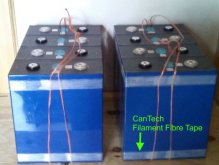Thanks, lots of good info.The JKbms with 2A Active Balancing is fine for the 280's, my packs all use those BMS'.
The B cells are Voltage & IR Matched and still quite reasonable at that price point. They are fine if you build a straight 8S Battery Pack with it's own BMS.
I have A Cells, B Cells, Used EV Cells in my bank. I have done numerous tests including extreme Thrash tests because of my situation, reliability is critical, especially when it's -35 outside. The A Cells certainly do perform better, with slightly faster charge because the cells are IR matched so very little balancing is required, they do give me the 280AH. My B cells are more finicky when finishing charge but it is not significant enough to be a problem. The Used EV cells are actually pretty darn good after I tweaked them. In "MY CASE" having 6 packs in a bank irons all that out and I do get 100% of my capacity... Yes, I've drained the entire bank to Low Volt Disconnect in tests.
I built my own boxes, I cannot ever recommend having the cells/terminals etc in "open air" - that's just begging for trouble! Even a Covered shelf with a clear cover in front... be safe !
I use MRBF Fuses because they are perfectly fine for <36V. These are cheaper than Class-T (as good) and make for a much cleaner install (depending on the individual of course LOL) You can see below, that the (+) Busbar is offset to allow the MRBF fuse to clear over it's (-)
Blue Sea MRBF fuses made by Eaton/Bussman (for 200A BMS, use 250A fuse)
MRBF Terminal Fuse Block - 30 to 300A - Blue Sea Systems
Easily and economically satisfies ABYC 7 circuit protection rule by mounting on a 3/8 battery post, battery switch or bus bar.www.bluesea.com
! WARNING ! There has been a LOT of Horse Pucks tossed about Binding/Compressing cells. It's been bad enough that people could have gotten to Physical Fistacuffs over it. The cells are to be BOUND snugly to prevent their expansion from twisting the terminal blocks. Do NOT put them under pressure !!! In fact, if you build the boxes below they fit the cells "snugly" and that's enough... Alternately Amy sells the Steel Cases for a more Pro finish, she also has Stackables that sit one ontop of the other... Not shown yet I think.

<--- Box Link:
Luyuan Diy Battery Box/case Set/kit For 8s 4s2p 24v 280ah 304ah 320ah Battery Pack With With Compression Battery/cell Device - Buy Larger Box For Men,Seed Storage Metal Box,Car Waterproof 12v Battery Box Product on Alibaba.com
Luyuan Diy Battery Box/case Set/kit For 8s 4s2p 24v 280ah 304ah 320ah Battery Pack With With Compression Battery/cell Device - Buy Larger Box For Men,Seed Storage Metal Box,Car Waterproof 12v Battery Box Product on Alibaba.comwww.alibaba.com
I built all my own boxes out of 3/4" - 19mm Plywood with a clear polycarbonate cover. See attached below. I am using Pike Industries BusBars shown below. https://pikeind.com/industries-busbars/


Yes my packs will be protected on all sides, but not tightly wrapped in a case. The inter-cell busbars are of the flexible type, so I don't think the terminals will be affected at all from cell swelling.
How did you pack the cells together before inserting into the boxes, tape? How is the BMS mounted?
Re cell compression, I'll follow your guide Luyuan_Tech_Basic_LiFePO4_guide_1a.pdf on page 8, and try to make a snug package to keep parts from moving around.
Re fuses, a 3.2V cell with 0.25 mOhm IR could in theory release a 12.8kA current. But the 0.5 m AWG0 cable I will use to connect to the main busbars (1m in cable total) will up the resistance to maybe 0.60 mOhm. Then the current would be 5,3kA. Looks like the Blue Sea MRBF can handle 5kA @ 32 VDC and even more as voltage drops, so it should be fine.
I'm on a tight budget. If I had more money, I'd double the capacity, get BMS displays for monitoring and proper boxes, but I think my current setup will work. This is my first version. I suspect I'll be learning and experimenting as I go along.




